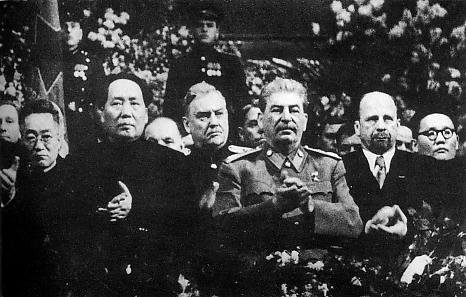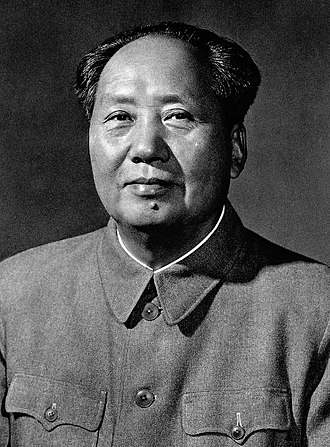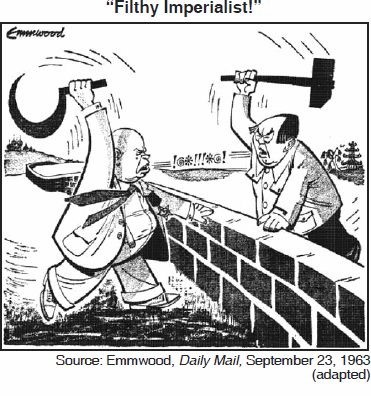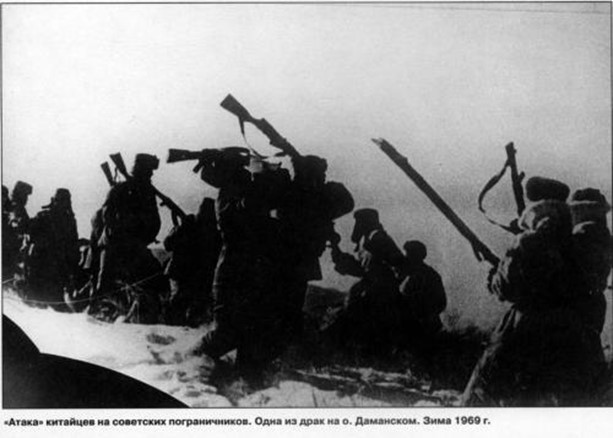

Table of Contents
Introduction
As a new world emerged from the ruins of World War II, a novel confrontation began to emerge. It was much less volatile, earning the nickname “Cold War”. It was an ideological and political struggle between two major world powers – the Soviet Union representing communism and the United States heralding capitalism. This simmering hostility went on to define international politics for the rest of the 20th century. Yet this simplified portrait of the struggle between eastern and western blocs is rather misleading because as it depicts two alliances as unified monoliths. This wasn’t true in neither case, but it was substantially more prominent in the communist sphere where two larges countries came to the brink of an actual armed confrontation.
Flourishing allies
The Sino-Soviet relations were initially quite close, as the Soviets assisted the Chinese Communist Party (CCP) during the civil war clash with Chiang Kai-shek’s nationalist forces. Thanks to this, Mao’s forces managed to win in 1949 forming the People’s Republic of China. The USSR then switched its support from the military to economic, granting substantial aid to underdeveloped and war-torn China. The Sino-Soviet closeness was publicly demonstrated in 1950 when two sides signed the Sino-Soviet Treaty of Friendship and Alliance. At its core, it was a security pact against foreign aggressions as well as an agreement for political, economic, and diplomatic cooperation. As such, it was much more vital for China than the Soviets, but it showed the world that the two nations were close allies. Adding to that was the fact that it was born after a personal meeting between Mao Zedong and Joseph Stalin in late 1949, with both of them signing it to showcase the significance of it.

Mao and Stalin during Mao’s visit to Moscow in 1949. WikiCommons
The Sino-Soviet alliance remained strong for the next couple of years, more precisely until Stalin’s death in 1953. By then the USSR has sent its Chinese friends substantial amounts of economic aid and various experts, backed its diplomatic feud regarding Taiwan (a remnant of Nationalist China), and provided general support for worldwide recognition of communist China. Even after Stalin’s death, the two remained close as several months later the Soviets were the closes Chinese allies in the Korean War. Until then, the CCP was strictly following the Soviet model for socialist development, both on the internal path but also in foreign politics. It seemed like China was like any other Soviet satellite state in Eastern Europe.
After Stalin’s death, a new current in Soviet politics rose, led by energetic Nikita Khrushchev. His politics were much more liberal in contrast to Stalin, while in foreign politics he proved more open for “peaceful coexistence” and trade with the capitalist west. This process of so-called destalinization culminated in 1956 when Khrushchev publicly denounced and criticized Stalin and his politics on the 20th congress of the Soviet communist party (CPSU). Such change in Soviet politics troubled Mao and his closest Chinese associates as their form of government was largely based on Stalinist principles, including the personality cult of the state leader. In effect, they felt Khrushchev’s criticism was partly aimed at them as well, as they weren’t officially or even unofficially informed of this important ideological change. Additionally, it could potentially threaten Mao’s grip on the Chinese government, as the CCP also had its more liberal wing, which could potentially overthrow him with Soviet support. Later on, Mao himself pinpointed the 20th congress as a starting point of the Sino-Soviet split.

Mao Zedong
From disagreement to open conflict
By 1956, Mao Zedong, CCP, and China started to feel more threatened by the Soviet disposition toward them. With that, other differences between the two nations became more apparent. For one, the Soviet Union was a much more developed nation, with a substantial industrial sector, while China remained an underdeveloped agricultural society. Additionally, the USSR felt strong enough both internally and externally to accept both societal liberalization and cooperation with supposed class enemies. In contrast, China was still threatened by the US presence in the region and possible foreign intervention in an attempt to overthrow CCP and restore Chiang Kai-shek. This fear of external intrusion only grew after the Soviet armed suppression of the Hungarian Revolution in late 1956. It implied that the Soviets could potentially intervene in China if they deemed it necessary or politically viable.
Over the next couple of years, dissatisfaction with the Soviet model and relations with “communist big brother” only grew among the Chinese leadership. As the Soviets veered further away from supposed proper socialism, China remained underdeveloped and far behind the USSR, while constantly feeling pressured to obey Soviet domination in the communist bloc. Slight cracks in the façade began to appear, but nothing substantial until 1958 when Mao finally decided to act. That year he unleashed the Great Leap Forward campaign which was supposed to accelerate Chinese development by abandoning the previous Soviet model. At the same time, China challenged the US-backed Taiwan in the so-called Second Taiwan Strait Crisis, disregarding the Soviet “peaceful cooperation” policy. This was followed by increasing ideological and propaganda debates between CCP and CPSU, though both claimed that their relations were still solid.

A UK newspaper caricature depicting Khrushchev and Mao arguing
Nonetheless, their relation deteriorated quickly as the Soviets began to withdraw their technicians and experts, most notably ones that helped the Chinese nuclear program, while the trade began to drop. At the same time, the Chinese Great Leap Forward began to exhibit extreme failure as a focus on industrialization caused massive famines. All the while, USSR began its détente with the US. The Great Leap rocked Mao’s position from within, while the improving US-Soviet relations caused a feeling of foreign threat and encirclement, prompting an even more aggressive Chinese stance towards the Soviet Union. The flurry on indirect insult grew, while the friendship of the two nations became less mentioned. The amicable disagreement turned to open conflict around 1962, when Mao openly criticized Soviet stance in the Cuban Missile Crisis, while the Soviets backed India in the Sino-Indian border clash.

Mao Zedong - Cultural Revolution propaganda poster. Wikipedia
From then on, two sides began open propaganda war, accusing each other of straying from the proper Leninist-Marxist path, with the rhetoric showing expressive hostility and attacks on a personal level. Even worse, the border between USSR and China became a highly militarized zone, with occasional skirmishes with both sides accusing the other of various transgressions. By 1965, it was clear the communist bloc wasn’t a monolithic formation, as the Chinese and the Soviets began competing over the primacy in the movement. The ideological and political rift was so deeply rooted in both nations that even changes in leadership (Khrushchev was deposed in 1964, while Mao died in 1976) weren’t enough to open any serious negotiation towards rapprochement. It was only in the mid-80s that two communist giants managed to find some common ground, though relations remained shaky until the dissolution of the USSR in 1991.
Sino-Soviet Cold War
Despite almost coming to a boiling point in 1969, when large border clashes on the Ussuri River almost sparked a full-blown conflict, Sino-Soviet relations remained akin to the “proper” Cold War. It is even safe to say that at certain points, like in ‘69, the relations between two communist giants were worse than their affairs with the US, supposed capitalist enemy. However, the US leadership never managed to utilize this to gain a proper upper hand in the diplomatic positioning. At first, most of the American leadership didn’t even believe the split was real, as some CIA documents reveal. Later on, Nixon’s administration tried to profit from the communist rift, but the issue of Taiwan remained an unsolvable hurdle. Regardless, the Sino-Soviet split, caused by ideological differences, pragmatic needs, as well as shrouded nationalism, proved to be an important aspect of 20th-century history. It transformed the Cold War from a bilateral duel, into somewhat of a triangle, as all three major powers began calculating with the other two in mind. In that aspect, all knew that China was the weakest of the three, yet it still had a sizable population and army, a nuclear arsenal since 1964, and a strong potential to grow which began to manifest in the late 70s.

Chinese troops during the 1969 Sino-Soviet border skirmish - from tumblr
Additionally, the Sino-Soviet split meant that two parties began to compete in the realm of spreading their official brand of socialism across the world. This was especially important in Africa and Southeast Asia, and to a lesser degree in the Middle East. In those regions, newly liberated nations sought their path from European colonialism into modernity and proper independence. Both China and the Soviet Union continued to send military support, financial aid, and political advice to various movements, organizations, and military groups, along with fully-fledged governments, adding yet another layer of complexity in the Cold War diplomacy. As such, inside the communist world two blocs arose. On one side, USSR with Warsaw pact, Mongolia and Cuba, later on with Vietnam as well. On the other was China, North Korea, Cambodia and Albania, with the last one becoming isolated from both since the late 70s. Romania and Yugoslavia were the only ones that tried to have friendly relations with both communist giants.
The rift also showcased the weakness in the communist ideology, as it proved that communism still hasn’t outgrown nationalistic tendencies passed down from previous generations, exampled by the border disputes. The Sino-Soviet relations also showed that when it came to competition for power and dominance, ideology played a minor role, another aspect of the Cold War that people often disregard. In the end, the divide between China and USSR ended up becoming a Cold War on its own, as two nations often put disputes between them as a primary point of foreign policy, though this was distinct in China. And while this was part of the global Cold War, it undeniably played a crucial role in its development as it transformed the world into a tripolar one, causing even more conflicts around the world, like for example between Cambodia and Vietnam in 1978. Luckily for the world, similar to the US-Soviet Cold War, the Sino-Soviet split never managed to get to nuclear heat.
Sources/Further reading
-
Austin Jersild, The Sino-Soviet Alliance: An International History, University of North Carolina Press, 2014.
-
Chi-kwan Mark, China and the world since 1945:an international history, Routledge, 2012.
-
Danhui Li and Yafeng Xia, Mao and the Sino-Soviet Split, 1959–1973 A New History, LEXINGTON BOOKS, 2018.
-
Lorenz M. Luthi, The Sino-Soviet split: cold war in the communist world, Princeton University Press, 2008.
-
Michael M. Sheng, Mao and China’s Relations with the Superpowers in the 1950s: A New Look at the Taiwan Strait Crises and the Sino–Soviet Split, Modern China (2008), Vol. 34 Number 4, October, 477-507.
-
Radchenko, S. (n.d.), The Cambridge History of the Cold War: Chapter 17 - The Sino-Soviet split, p 349–372., Cambridge University Press, 2010.
-
Zhihua Shen And Yafeng Xia, The Great Leap Forward, the People’s Commune and the Sino-Soviet Split, Journal of Contemporary China (2011), 20(72), November, 861–880.
